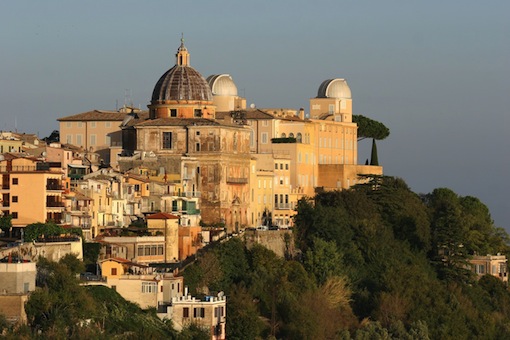Few images in recent Catholic history will be remembered like the ones that marked Benedict XVI’s last day as pope: Bidding farewell to well-wishers at the Vatican, the departing pontiff boarded a helicopter, en route to Castel Gandolfo, the papal summer residence just outside Rome. Upon arrival, he was greeted by the town’s residents, who heard him deliver his last address as pope, in which he spoke movingly about being a pilgrim of the Lord.
The occasion gave rise to some surprisingly sympathetic stories about the papal residence, which has an eventful history. In a report for the New York Times , Elisabetta Povoledo described how the papacy first laid claim to Castel Gandolfo (originally a small fortress) in 1596, but did not really become associated with it until 30 years later, when Pope Urban VIII, who had a wing built on the side which overlooks Lake Albano, made it an official papal residence. Pope Alexander VII later commissioned Gian Lorenzo Bernini, the great Baroque architect, to construct a second wing, and successive popes have made further additions and renovations. Today, writes Povoleda, the residence has become something of a world unto itself: “The pontifical villas of Castel Gandolfo cover a triangle-shaped swath of the town, totaling about 135 acres. A working farm provides produce—fruits and vegetables, oils, eggs and dairy products—to the pope’s kitchens, both here and in Vatican City.”
After noting that Castel Gandolfo retains “considerable interaction” with the local 9,000 residents, Povoledo commented:
Townspeople of a certain age still recall the protection given by Pope Pius XII after Allied troops landed in Anzio in 1944 and the area became an open war zone. Some 12,000 people found refuge in the pontifical villas. ‘Around here there are many people named Pio or Pia, Eugenio or Eugenia,’ in honor of Eugenio Pacelli, who became Pius XII, said Pier Paolo Turoli, an administrator of the Pontifical Villas at Castel Gandolfo.
This remarkable acknowledgement of papal humanitarianism was refreshing, given how frequently the modern Times has mistreated Pius and the Church. Yet Povoledo’s coverage is thoroughly in keeping with the Times ’ own wartime reporting, which—-at least back then—-was quite fair to Pius XII.
During the German occupation of Rome, and particularly in a series of reports published in February, 1944—on the 11th, 15th, and 18th of that month—the Times covered the Holy See’s heroic work for endangered refugees, underscoring the pope’s efforts to secure their protection. (Concurring with Povoledo, these dispatches reported that somewhere between ten to fifteen thousand people were being cared for at Castel Gandolfo alone.)
The National Catholic Welfare Conference said . . . the Pope had opened the Papal villa at Castel Gandolfo, including the official apartments, to some 15,000 persons, mostly women and children . . . .
The Vatican radio on Feb. 15 stated that more than 10,000 refugees still remained at the Papal villa, adding that it was not yet possible for them to go elsewhere. Consequently, the broadcast said, any warlike action against the Papal villa not only would be a violation of its extra-territorial rights but would imperil thousands of defenseless people.
Re-reading these reports brought back memories of my own visit to the historic papal site. In September 2008, I participated in a conference on Pius XII and the Jewish community, which culminated in a special audience with Pope Benedict XVI at Castel Gandolfo. His address , recalling Pius XII’s compassion and support for the war’s many victims, had tremendous symbolic significance, since it was at Castel Gandolfo where persecuted Jews had been given refuge by Pius XII. When Rome was finally liberated, they came to personally thank him for the life-saving assistance he had provided. On June 22, 1944—just weeks after the liberation—-the Palestine Post (today’s Jerusalem Post ) reported from Vatican City :
Several thousand refugees, largely Jews, during the weekend left the Papal Palace at Castel Gandolfo—the Pope’s summer residence near Marino—after enjoying safety there during the recent terror. Besides Jews, persons of all political creeds who had been endangered were given sanctuary at the Palace. Before leaving, the refugees conveyed their gratitude to the Pope.
The Catholic Herald of Britain also covered this extraordinary event at the time, which is important, since a number of critics have questioned whether Jews really were rescued by Pius XII at Castel Gandolfo. They certainly were.
In addition to the Times report, Germany’s Der Spiegel ran a largely positive story about Castel Gandolfo, also focusing on World War II. While the magazine seems unaware of Pius XII’s quick and decisive protests against the German round-up of Rome’s Jews, it does record his anti-Nazi convictions (as well as those of his predecessor, Pius XI), and goes on to note how Pius XII “would order churches, cloisters and other Vatican properties—-including Castel Gandolfo—to be used to shelter for those being targeted.”
Castel Gandolfo has been far more than just a papal retreat: it has served as a life-giving enclave which represents the highest values of Christianity. As such, it is a fitting location for the pope emeritus to stay and pray at, before taking up permanent residence back in Rome.
Rome and the Church in the United States
Archbishop Michael J. Curley of Baltimore, who confirmed my father, was a pugnacious Irishman with a taste…
Marriage Annulment and False Mercy
Pope Leo XIV recently told participants in a juridical-pastoral formation course of the Roman Rota that the…
Undercover in Canada’s Lawless Abortion Industry
On November 27, 2023, thirty-six-year-old Alissa Golob walked through the doors of the Cabbagetown Women’s Clinic in…


